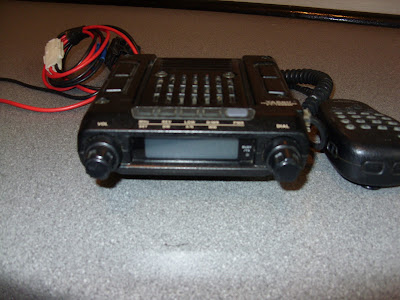Amateur Radio in the UK
I know what it is about......Self Learning and the enjoyment of radio communication.
My good lady tells me it's just a excuse for collecting clutter.
The world of Amateur Radio covers many things but to start with the thing you want the most is the licence to use it. When I took the Licence in 1985 there was two types Class A and Class B both of them had the same technical qualification but Class A included a Morse Code test which if you passed it entitled you to transmit on the shortwave(hf) bands. The use of the word class in the licence type was frowned upon in some quarters, but it never bothered me.
The new licence is in three parts. No more Morse test.
(shame)
This new licensing format no matter how far you progress with it allows you to use all the amateur radio bands.
THE FOUNDATION
The content requirement for the exam is based on technical, theory and the know how to understand the Licensing requirements.
The starter licence is called the Foundation and you are required to study for what should be about a couple of weeks before you take the exam. You will learn radio theory as well as a sprinkling of electronics and aerials.
Like most exams these days it is multiple choice of and it consists of 25 questions and you will know your result before you leave the exam room. After applying for your licence you will receive a callsign which is special to you and I speak from experience when I say this callsign becomes a part of you. You will be allowed unsupervised to transmit with a maximum transmitter output power of 10watts on all bands.
THE INTERMEDIATE
If you decide to advance yourself and go for and achieve the Intermediate Licence you will give up the callsign that you was issued with when you passed the foundation. You will be issued with a new callsign that will denote your new status. You will also be allowed to use 50 watts of transmitter power.
If you decide to go to the next level another course is not officially needed but if you are not confident that you have the skills to advance to the Intermediate licence I recommend that you attend a course and do a bit more studying. Even if you think that you already have the knowledge there is nothing wrong with a recap.
As you may guess the Intermediate course is a bit more challenging and you learn more fundamentals which would include soldering and building some item as a project. Hopefully these new skills will add to what you learnt in the Foundation course and you be successful in achieving the Intermediate licence. If you are successful and you pass this exam you will be supplied with a Intermediate grade call sign.The exam for the Intermediate Licence has more multiple choice questions and the exam time will be longer.

If you carry on and pass the exam for the Intermediate Licence you can use this VHF 2metre fm rig on full power which is 50 watts transmit. It is a Yaesu FT 1500M mobile rig and with it's 50 watts it can deliver a signal when used with the correct aerial that will get you heard. It has got other transmit power settings so no need to run full power when not needed. It can be more of a challenge to work lower power (QRP) and you sense greater satisfaction knowing that you have just transmitted across 50 miles using just 5 watts.
THE ADVANCED
If you decide to sit this exam and pass it you will now have the same type of licence as me. This FULL licence will allow you 400 watts of transmitter power and you can now rub shoulders with the big boys or the big girls. You will have to change your callsign again, but this will be the last time and you can keep this one for life.
The link below will take you to the
Ofcom website witch will tell you how to claim your licence.
https://services.ofcom.org.uk/faqs?faqcat=amateurradio
The advance course is somewhat harder than the Intermediate and you will have to put in some effort to achieve a pass in it. You can learn the this theory based exam at home or with members of your local radio club. You can contact the leading British Amateur Radio Society which is the
Radio Society of Great Britain and the link is in the right hand sidebar of this Blogspot. You can find on this
RSGB site affiliated Amateur Radio Club listings along with their contact details. You will also be able to find more information about the Amateur Radio courses and exams and much more besides.
Please remember that Morse code is still in use on the amateur bands but you will not be able to understand it. There is nothing to stop you from learning it, I hope you give it ago.
A Morse code reader, is in my opinion a very good aid for learning the code, it worked for me.
All the best



